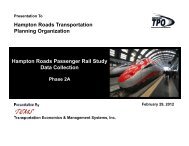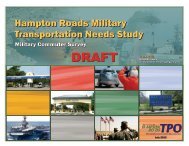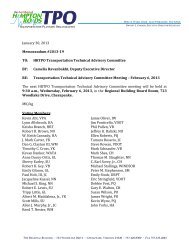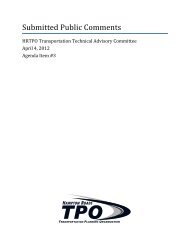Hampton Roads Regional Bridge Study
Hampton Roads Regional Bridge Study
Hampton Roads Regional Bridge Study
Create successful ePaper yourself
Turn your PDF publications into a flip-book with our unique Google optimized e-Paper software.
BRIDGE DEFINITIONS 3<br />
BRIDGE DEFINITIONS<br />
As part of the <strong>Regional</strong> <strong>Bridge</strong> <strong>Study</strong>, producing a definition of the term<br />
“bridge” was necessary to determine which structures to include in the<br />
analysis. <strong>Hampton</strong> <strong>Roads</strong> Transportation Planning Organization (HRTPO)<br />
staff relied on the National <strong>Bridge</strong> Inspection Standards (NBIS) definition<br />
of a bridge, which is used to determine those structures that are included<br />
in the National <strong>Bridge</strong> Inventory (NBI). The NBIS definition of a bridge is<br />
as follows:<br />
“A structure including supports erected over a depression or an<br />
obstruction, such as water, highway, or railway, and having a track<br />
or passageway for carrying traffic or other moving loads, and having<br />
an opening measured along the center of the roadway of more than<br />
20 feet between under copings of abutments or spring lines of<br />
arches, or extreme ends of openings for multiple boxes; it may also<br />
include multiple pipes, where the clear distance between openings is<br />
less than half of the smaller contiguous opening.”<br />
inspection procedures are included in this study, but tunnels are<br />
not included in report statistics since many of the metrics used to<br />
measure bridge conditions do not apply to tunnels.<br />
BRIDGE TYPES<br />
<strong>Bridge</strong>s vary greatly in design, from small culverts to mile long suspension<br />
bridges. FHWA uses 22 classes to categorize structures based on the<br />
predominant type of design and construction. Figure 1 on page 4<br />
describes each bridge type and includes the number of each type of<br />
bridge in <strong>Hampton</strong> <strong>Roads</strong>.<br />
Using the NBIS definition as a guide, HRTPO staff determined that the<br />
following conditions should apply for each bridge to be included in this<br />
study:<br />
<br />
<br />
<br />
<br />
Location – The bridge must be located on roadways open to the<br />
general public. <strong>Bridge</strong>s owned and maintained by local, state,<br />
and federal government agencies apply, as do bridges owned and<br />
maintained by private operators so long as they are open for<br />
public use. <strong>Bridge</strong>s located within the security perimeter of<br />
military bases are not included in this study, although they are<br />
generally included in the NBI.<br />
Length – The bridge must be more than 20 feet (6.1 meters) in<br />
length per the NBIS. Culverts are included, so long as the<br />
opening in the culvert is more than 20 feet in length.<br />
Service – The bridge must carry a roadway. Structures that carry<br />
only railroad or pedestrian traffic are not covered by NBIS<br />
regulations and are not included in this study.<br />
Tunnels – Tunnels are not considered bridges by the NBIS.<br />
Information regarding <strong>Hampton</strong> <strong>Roads</strong> tunnels and tunnel<br />
JAMES RIVER BRIDGE VDOT<br />
HAMPTON James City/Williamsburg/York ROADS REGIONAL Transportation BRIDGE STUDY <strong>Study</strong>












